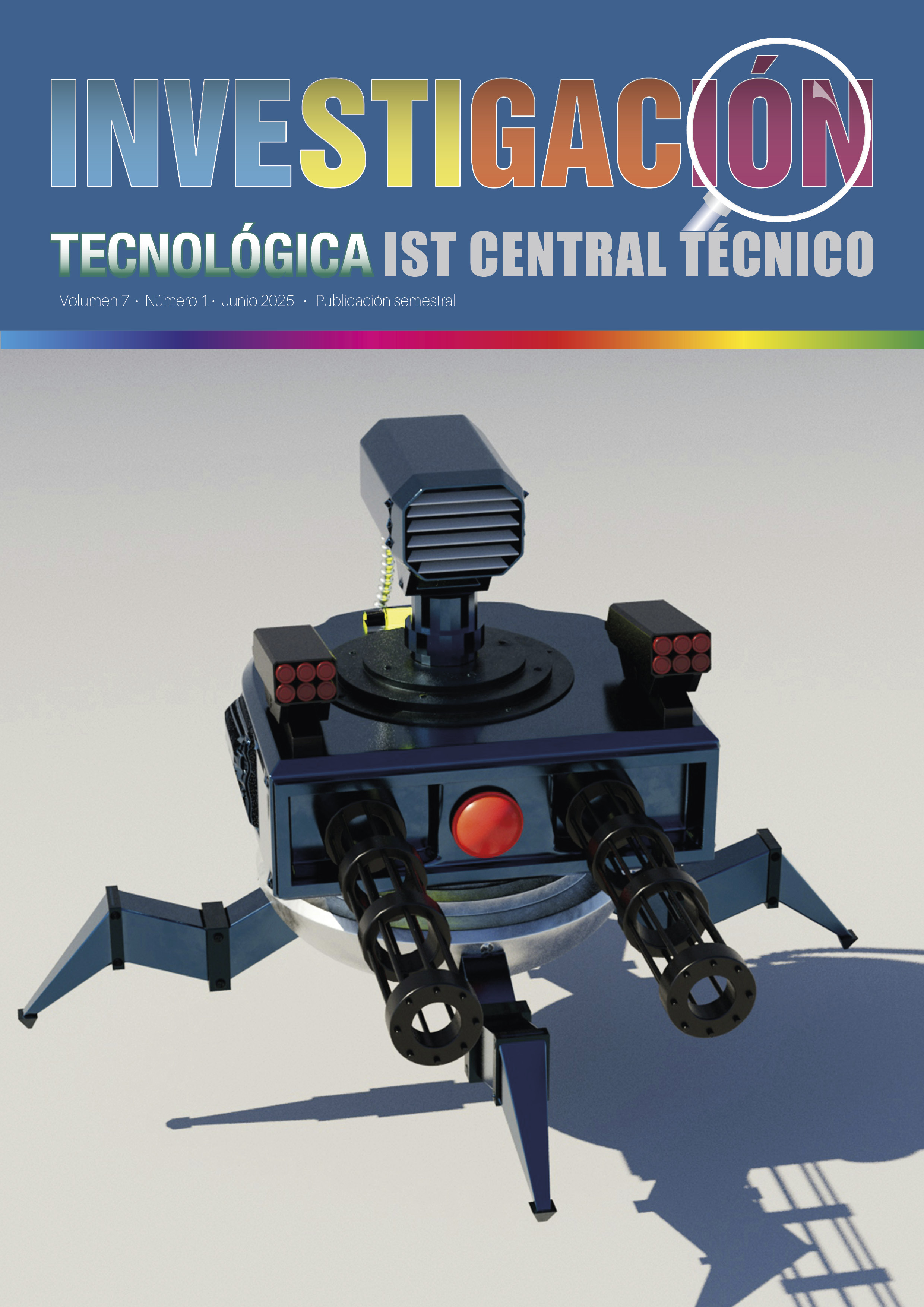Technical feasibility analysis for the implementation of solar tunnels: case of Santa María supermarket in Sangolquí.
Keywords:
Solar tunnels, environmental impact, energy consumption, energy efficiency, technical feasibility.Abstract
This study analyzed the technical feasibility of installing solar tunnels at the Santa María Shopping Center, located in Sangolquí. The main objective was to study the environmental impact of this technology, focusing on its ability to reduce both electricity consumption and greenhouse gas emissions. To achieve this, a quantitative approach was adopted, conducting lighting measurements at 20 key points, which were classified into different categories to calculate average light levels at various times of the day. The findings showed that the use of solar tunnels could significantly reduce artificial energy consumption and pollutant emissions. This technology is presented as an efficient alternative to optimize energy consumption and contribute to environmental care by reducing dependence on non-renewable energy sources. However, despite the benefits in terms of energy savings, it was determined that the time required to recover the initial investment is too long, making the project unfeasible under current conditions. The environmental benefits of this solution were also analyzed, considering the initial costs and long-term savings.
References
• Alemán, E. I. M. (s. f.). Cálculo del número de luminarias para un espacio arquitectónico por el método de lúmenes. Unidades de Apoyo para el Aprendizaje - CUAIEED - UNAM. Recuperado de https://uapa.cuaieed.unam.mx/sites/default/files/minisite/static/099ccabb-1893-46cc-a291-897d9bc59078/contenido/index.html#:~:text=El%20m%C3%A9todo%20de%20l%C3%BAmenes%20determina,proyecto%20de%20la%20instalaci%C3%B3n%20el%C3%A9ctrica
• Cantón Rumiñahui. (s. f.). Provincia de Pichincha. Recuperado de https://pichinchaesturismo.com/es-ec/pichincha/ruminahui/ciudades/canton-ruminahui-aqm1uegqq
• Deloitte. (2019). Normas Internacionales de Información Financiera - NIIF 2019: Completas. Recuperado de https://www2.deloitte.com/content/dam/Deloitte/cr/Documents/audit/documentos/niif-2019/NIIF-2019-Completas.pdf
• Doinglight. (2024, 27 agosto). El tubo solar de luz natural | Guía práctica de uso y beneficios. Doinglight España. Recuperado de https://www.doinglight.es/tubo-solar/
• Factorenergia, E. T. E. (2023, 18 mayo). ¿Qué es la radiación solar directa e indirecta? Y su importancia en la fotovoltaica. Recuperado de https://www.factorenergia.com/es/blog/autoconsumo-electrico/que-es-la-radiacion-solar-directa-e-indirecta-y-su-importancia-en-la-fotovoltaica/
• González, J. (2023). Método del Lumen [Artículo]. ResearchGate. Recuperado de https://www.researchgate.net/publication/371986125_Metodo_del_Lumen
• Guerrero, J. (2018). Estudio de viabilidad de un sistema de energía solar fotovoltaica en el campus de la Universidad Politécnica Salesiana (Tesis de grado, Universidad Politécnica Salesiana). DSpace. Recuperado de https://dspace.ups.edu.ec/bitstream/123456789/10253/1/UPS-GT001344.pdf
• Guía Técnica de Iluminación Eficiencite para el Sector Retail. (2016, febrero 16). Issuu. Recuperado de https://issuu.com/guias-agencia-ee/docs/gui__a_te__cnica_de_iluminacio__n_e
• J, H. (2019). Diez innovaciones de aparcamiento sostenible para un entorno más sostenible. Intertraffic. Recuperado de https://www.intertraffic.com/news/parking/ten-sustainable-parking-innovations-for-a-more-sustainable-environment
• McCasland, M., Stater Bros. Markets, Inc., & Solatube International, Inc. (2007). Case Study. In Stater Bros. Recuperado de https://solatube.com/wp-content/uploads/2019/03/case-study-retail-stater-bros.pdf
• Solargis. (s. f.). Global Solar Atlas. The World Bank Group. Recuperado de https://globalsolaratlas.info/map?s=-0.311736,-78.460922&m=site&c=-0.32929,-78.451338,11
• Solatube. (2024, 29 marzo). Sustainability - Solatube. Recuperado de https://solatube.com/commercial/sustainability/
• Solatube International, Inc. (2015). Byerly’s Supermarket Case Study. Recuperado de https://solatube.com/wp-content/uploads/2019/03/retail-byerlys-case-study.pdf
• Solatube International, Inc. (2018). SIPCO- Jeddah Distribution Center. In Solatube M74. Recuperado de https://solatube.com/wp-content/uploads/2019/03/Sipco_Pepsico_Warehouse_Jeddah_Saudi_Arabia1.pdf
• Solatube International, Inc. (2019). Aqua Lung Warehouse Case Study. Recuperado de https://solatube.com/wp-content/uploads/2019/03/Aqua-Lung-Warehouse-Case-Study.pdf
• Solatube International, Inc. (2019). Industrial Case Study: Algae to Omega. Recuperado de https://solatube.com/wp-content/uploads/2019/03/case-study-industrial-algae-to-omega_1.pdf
• Solatube International, Inc. (2020). Solatube 330DS: Ficha técnica. Recuperado de https://www.solatube.com/330ds-tech-sheet.pdf
• Túnel-Solar. (s. f.). Recuperado de https://www.velux.lat/productos/tunel-solar
• Universidad Técnica del Norte. (s. f.). UNE 12464: Norma de iluminación en entornos de trabajo. Recuperado de https://www.studocu.com/ec/document/universidad-tecnica-del-norte/seguridad-industrial/03-une-12464-norma/43060881

Downloads
Published
How to Cite
Issue
Section
License
Copyright (c) 2025 Omar Fernando Sánchez Olmedo

This work is licensed under a Creative Commons Attribution-NonCommercial 4.0 International License.
COPYRIGHT
The ISTCT Technological Research journal is an Open Access publication, whose contents are disseminated under a Creative Commons Attribution-Non-Commercial license (CC-BY NC 4.0 International). All articles published in the ISTCT Technological Research journal are published in Open Access and are available online for free immediately after publication.
This journal provides metadata for third-party indexing services through the open files initiative.
The ISTCT Technological Research journal recognizes and respects the moral rights of the authors, as well as the ownership of the patrimonial right, which will be transferred non-exclusively to the journal to allow its legal dissemination in Open Access.
The ISTCT Technological Research journal does not reserve the rights to publish articles. Authors may distribute their own material in any other medium or medium, as long as it is for non-commercial purposes, informing the editors that the work will be published again and giving the corresponding credit to the ISTCT Technological Research journal.
Authors can make other independent and additional contractual agreements for the distribution of the article published in this journal (e.g., include it in an institutional repository or publish it in a book) as long as they clearly indicate that the work was published for the first time in "ISTCT Technological Research Magazine". In the case of reproduction, a note similar to the following must be included:
"This text was originally published in REVISTA DE INVESTIGACIÓN TECNOLÓGICA ISTCT N ° -, section -----, number of pages, year of publication."
Authors are recommended to publish their work on the Internet (for example on institutional or personal pages) in the final version published by REVISTA DE INVESTIGACIÓN TECNOLÓGICA ISTCT, as it may lead to a greater and faster dissemination of the published work (see The Effect of Open Access).
The publications in this magazine, due to their free nature, do not entitle the authors to any financial remuneration.


